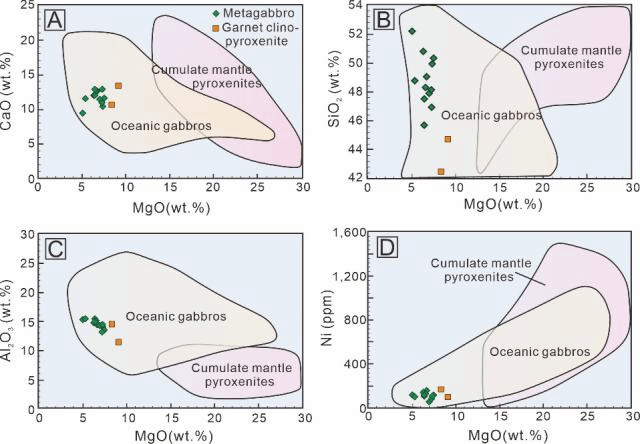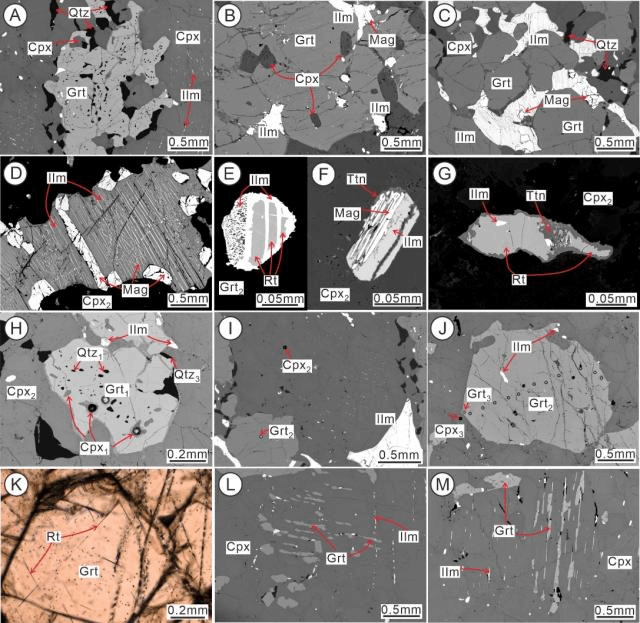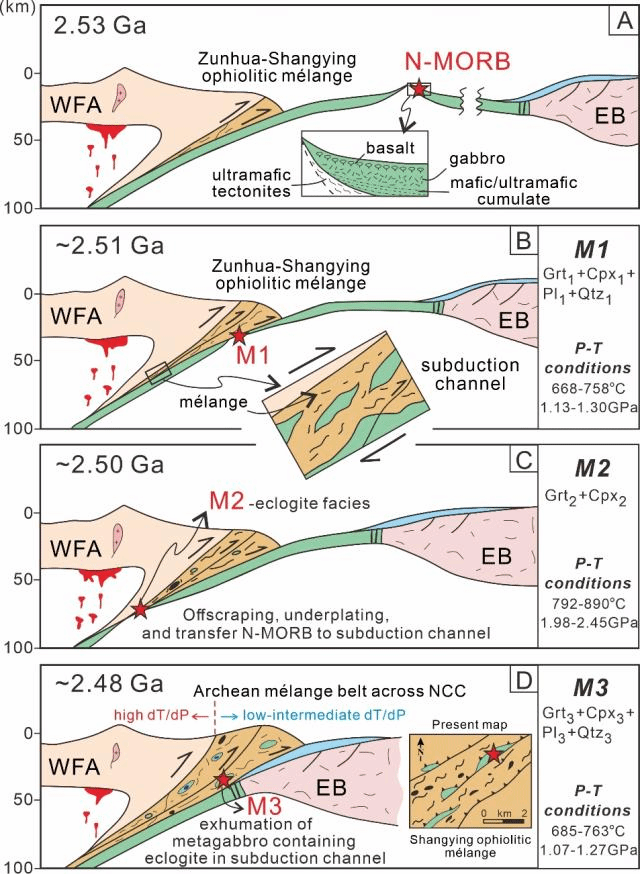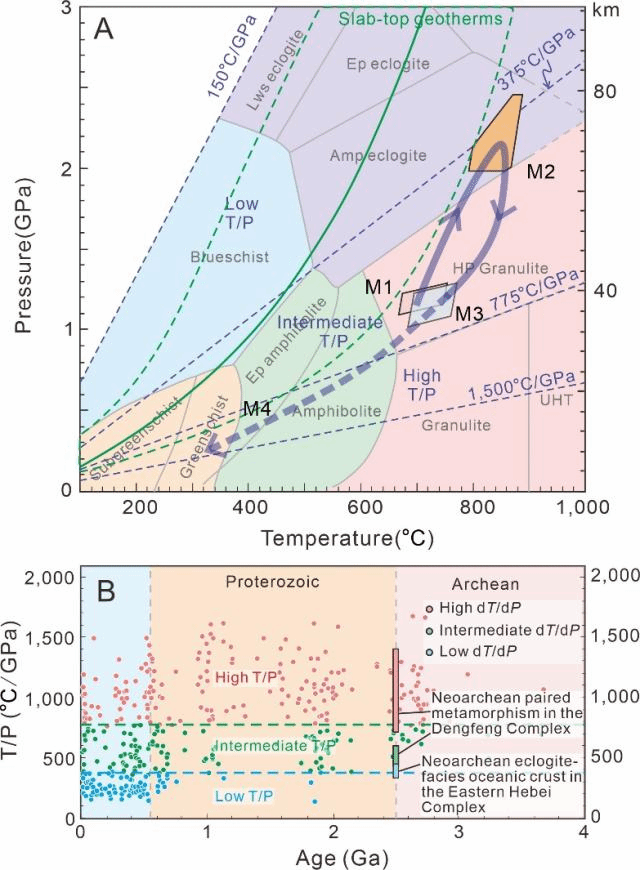新太古代榴辉岩相洋壳指示现代板块构造至少启动
于25亿年前
板块构造理论是当今地球科学界最重要的理论之一。板块构造通过汇聚板块边缘的俯冲作用和洋中脊的岩浆作用将地球表面和内部各个圈层联系起来,是地球内部热耗散的重要机制,也是宜居地球形成的最重要的主控因素。关于板块构造的启动及其演化,是地学界的国际前沿和热点话题。目前主流观点认为,随着地幔的不断冷却,岩石圈厚度及强度发生改变,板块构造样式也随之不断发生变化,从早期板块构造转变为现代板块构造。其中现代板块构造背景下汇聚边界典型产物是高压/低温变质的榴辉岩。但由于太古宙尚未发现榴辉岩或榴辉岩相的地壳岩石,关于现代板块构造在太古宙是否已经启动,一直是未解之谜。
近日,中国地质大学(武汉)全球大地构造中心主任Timothy Kusky教授带领的团队,在大地构造理论和方法的指导下,通过多年野外精细填图、室内变质岩石学、岩石地球化学和地质年代学等综合研究,首次发现并报道了华北克拉通遵化构造带内出露的新太古代末期(~2.5 Ga)造山型榴辉岩化残留洋壳,这是地球上目前已知最古老的俯冲洋壳形成的榴辉岩相岩石(石榴单斜辉石岩)。该发现为“现代板块构造在太古宙就已启动”提供了关键岩石学证据。研究成果于2022年4月4日发表在著名综合类期刊《PNAS》(《美国科学院院刊》) (W.B. Ning等, 2022),文章第一作者为中国地质大学(武汉)地球科学学院博士生宁文彬,通讯作者为Timothy Kusky和王璐教授,合作作者为湖北巴东地质灾害国家野外科学观测研究站黄波副研究员。
通过多年系统研究,该研究团队在冀东杂岩遵化构造带内识别出了一套具有典型“基质夹岩块”特征的岩石组合,类似于现今增生型造山带中的混杂岩(Kusky等, 2020)。对该混杂岩进行多学科综合研究表明,它是一套在新太古代末期(2.50-2.52 Ga)侵位的含弧前蛇绿岩残片的混杂岩,命名为遵化-上营蛇绿混杂岩(图1)(Kusky等, 2010; J.P. Wang等, 2019; W.B. Ning等, 2020; Y. Huang等, 2021)。W.B. Ning等(2022)对该混杂岩中变辉长岩团块及其包裹的石榴单斜辉石岩进行全岩主微量元素分析,结果表明它们具有N-MORB(正常洋中脊玄武岩)的地球化学特征。此外,变辉长岩中锆石Hf同位素显示出亏损地幔的源区特征,且野外发现变辉长岩具有层状和均质两种产状,这些特征与现代洋壳中辉长岩的特征一致。石榴单斜辉石岩的MgO, SiO2, Al2O3, Ni等主微量元素特征也表明其是大洋辉长岩变质而来(图2)。对变辉长岩及切穿变辉长岩面理的花岗质岩脉进行锆石U-Pb定年限定了该期变质作用主要发生于2.47 Ga之前。
岩相学观察表明石榴单斜辉石岩保留了从进变质,峰期到峰期后退变质的多期矿物组合。通过多种矿物对的主微量元素温压计限定出峰期矿物组合(石榴石核部+单斜辉石核部)的变质温压条件为792–890°C/1.98–2.45 GPa,达到榴辉岩相变质级别。此外,石榴单斜辉石岩的岩相学显微结构同样指示了UHP-HP的峰期变质条件,如石榴石表面出溶针状金红石、单斜辉石表面出溶带状石榴石以及自形钛铁矿中部被富Al榍石分离等现象(图3)。综合以上研究成果,作者认为遵化-上营蛇绿混杂岩中的石榴单斜辉石岩和变辉长岩团块代表了俯冲的太古宙洋壳,该俯冲洋壳在65-70 km深度处发生榴辉岩相变质作用,随后断离并在俯冲隧道中发生差异性折返,构成蛇绿混杂岩(图4)。
结合研究团队在华北克拉通中部造山带北部发现的新太古代末期建平混杂岩、中部赞皇杂岩内的构造混杂岩以及南部登封杂岩内的俯冲-增生杂岩及双变质带等汇聚板块边界判别性地质证据,表明新太古代末期已存在大规模的斜向俯冲,该俯冲带可长达1600 km,且存在洋壳深俯冲(图5)。W.B. Ning等(2022)报道了目前已知最古老的造山带洋壳型榴辉岩,将之前学界公认的榴辉岩相变质作用时间提前400 Ma,同时表明在新太古代末期洋壳已经能够俯冲到至少65-70 km深度,标志着现代板块构造在太古宙末期就已经启动。

图1. 华北克拉通构造划分及上营地区地质图。注意遵化-上营蛇绿混杂岩中变辉长岩团块核部包裹石榴单斜辉石岩。

图2. 石榴单斜辉石岩的主量元素与大洋辉长岩和幔源堆晶辉石岩对比图。可看出上营石榴单斜辉石岩具有低MgO和高Al2O3含量,类似于现代大洋辉长岩。

图3. 石榴单斜辉石岩的岩相学照片。注意图K中石榴石出溶针状金红石,图L-M中单斜辉石出溶带状石榴石。

图4. 新太古代末-早元古代初遵化-上营蛇绿混杂岩的形成演化模式图。

图5.华北克拉通冀东杂岩内遵化-上营蛇绿混杂岩中石榴单斜辉石岩的变质阶段的温压条件及P-T轨迹。注意峰期变质阶段(M2)的温压条件达到了榴辉岩相系,指示新太古代末期洋壳的俯冲深度可达65-70 km。结合在华北克拉通中部造山带北部发现的建平辉石岩混杂岩,中部赞皇构造混杂岩及南部登封杂岩内新太古代末的双变质带,表明新太古代末期已存在大规模的板块水平运动(俯冲带可长达1600 km),并在局部存在洋壳深俯冲。
参考文献:
Ning, W. B., Kusky, M.T., Wang, L., Huang, B. Archean eclogite-facies oceanic crust indicates modern-style plate tectonics. Proceedings of the National Academy of Sciences of the United States of America, https://doi.org/10.1073/pnas.2117529119 (2022).
Kusky, T. M., Wang, J.P., Wang, L., Huang, B., Ning, W.B., Fu, D., Peng, H.T., Deng, H., Polat, A., Zhong, Y.T., Shi, G.Z. Mélanges through time: Life cycle of the world's largest Archean mélange compared with Mesozoic and Paleozoic subduction-accretion-collision mélanges. Earth Science Reviews 209, https://doi.org/10.1016/j.earscirev.2020.103303 (2020).
Kusky, T. M., Li, J.H. Origin and emplacement of Archean ophiolites of the central orogenic belt, North China craton. Journal of Earth Science 21, 744-781, https://doi.org/10.1007/s12583-010-0119-8 (2010).
Wang, J. P., Li, X.W., Ning, W.B., Kusky, T.M., Wang, L., Polat, A., Deng, H. Geology of a Neoarchean suture: Evidence from the Zunhua ophiolitic mélange of the Eastern Hebei Province, North China Craton. Geological Society of America Bulletin 131, 1943-1964, https://doi.org/10.1130/B35138.1 (2019).
Ning, W. B., Kusky, M.T., Wang, J.P., Wang, L., Deng, H., Polat, A., Huang, B., Peng, H.T., Feng, P. From subduction initiation to arc–polarity reversal: Life cycle of an Archean subduction zone from the Zunhua ophiolitic mélange, North China Craton. Precambrian Research 350, https://doi.org/10.1016/j.precamres.2020.105868 (2020).
Huang, Y., Wang, L., Robinson, P.T., Ning, W.B., Zhong, Y.T., Wang, J.P., Hu, W., Polat, A., Kusky, T. Podiform chromitite genesis in an Archean juvenile forearc setting: The 2.55 Ga Zunhua chromitites, North China Craton. Lithos 394-395, https://doi.org/10.1016/j.lithos.2021.106194 (2021).
Archean eclogite-facies oceanic crust indicates modern-style plate tectonics
The plate tectonic theory is one of the most important achievements in Earth Science. It connects Earth's surface and interior systems through subduction of lithospheric plates and magmatism along mid-ocean ridges, and is an important mechanism for heat and material transfer from Earth's interior, and also the most important controlling factor for the formation of a habitable Earth. The operation and evolution of plate tectonics are international frontier and hot topics in geosciences. The prevailing view about the development of plate tectonics on Earth is that, with the continuous cooling of the mantle, the thickness and strength of the lithosphere changed, resulting in the transition of the plate tectonic style, from early-style plate tectonics to modern-style plate tectonics. A rare but diagnostic product of convergent boundaries in the modern plate tectonic mosaic is HP/LT metamorphic rocks known as eclogites. However, a lack of Archean age (2.5 Ga) eclogites or eclogite-facies crustal rocks has led to an assertion that modern plate tectonics did not operate in the Archean.
Recently, the research team led by Professor Timothy Kusky, Director of the Centre for Global Tectonics at China University of Geosciences (CUG, Wuhan), has reported late Neoarchean (~2.5 Ga) eclogite-facies oceanic crust within the Zunhua-Shangying ophiolitic mélange of the North China Craton (NCC). This is the oldest known orogenic eclogite-facies oceanic crust remnant on Earth, and its discovery and documentation provide a key petrological constraint for the operation of modern plate tectonics by the Neoarchean (2.5 Ga). The research results are published in the prestigious top-rated journal PNAS (W.B. Ning et al., 2022). The first author of the paper is Wenbin Ning, a doctoral student of the School of Earth Sciences. The corresponding authors are Professor Timothy Kusky and Lu Wang of the School of Earth Sciences and the State Key Laboratory of Geological Processes and Mineral Resources. The co-author is Bo Huang, an Associate Researcher of the Badong National Observation and Research Station of Geohazards.
Through years of systematic research, the team has identified a set of rock assemblages with typical mélange 'block-in-matrix' fabrics in the Zunhua structural belt, a section of the Central Orogenic Belt in the Eastern Hebei region. The Zunhua mélange is similar to mélanges of Phanerozoic accretionary orogenic belts (Kusky et al., 2020). The multidisciplinary comprehensive study of the mélange reveals that it is a fore-arc ophiolitic mélange formed at the end of the Neoarchean (2.50–2.52 Ga), and has been named the Zunhua-Shangying ophiolitic mélange (Figure 1) (Kusky et al., 2010; J.P. Wang et al., 2019; W.B. Ning et al., 2020; Y. Huang et al., 2021). W.B. Ning et al. (2022) carried out the field mapping, whole rock major and trace elements analyses of metagabbro blocks and enclosed eclogitic garnet clinopyroxenite as part of his PhD studies in the Central for Global Tectonics at CUG. The results show that these rocks have geochemical affinities of N-MORB (normal mid-ocean ridge basalts), and the Hf isotopes of zircon separated from the metagabbro reveal a depleted mantle source. Moreover, the metagabbros include both layered and isotropic varieties, consistent with the characteristics of gabbro complexes in modern oceanic crust sections. The MgO, SiO2, Al2O3, Ni and other major-trace element signatures of the garnet clinopyroxenite suggest it formed as the metamorphosed oceanic gabbro (Figure 2). Zircon U-Pb dating of the metagabbro and granitic veins that cut through the metamorphic layering of the metagabbro constrain that the oceanic gabbros formed at 2.53–2.52 Ga, and were metamorphosed before 2.47 Ga.
Petrographic observations reveal that the garnet clinopyroxenite preserved mineral assemblages of prograde metamorphism, peak to post-peak retrograde metamorphism. The metamorphic P-T conditions for the peak mineral assemblage (garnet core + clinopyroxene core) are 792–890°C/1.98–2.45 GPa, calculated by multiple mineral pair major and trace element geothermobarometers. The retrieved P-T conditions indicate the garnet clinopyroxenite experienced eclogite-facies metamorphism. In addition, the microstructure of the garnet clinopyroxenite also confirms the retrieved UHP-HP metamorphic conditions, such as the exsolution of needle-like rutile on the garnet, the exsolution of garnet rods on the clinopyroxene surface, and the separation of the central part of the idiomorphic titanite by the Al-rich mineral phase (Figure 3). The authors conclude that the garnet clinopyroxenite and metagabbro blocks in the Zunhua-Shangying ophiolite mélange represent a remnant of subducted Archean oceanic crust, which subducted to a depth of 65–70 km, followed by the breakup of the oceanic crust, tectonic mixing, and differential exhumation in a subduction channel to form the ophiolite mélange (Figure 4).
Combined with other evidence for Neoarchean asymmetric subduction along the eastern margin of the Central Orogenic Belt (COB) of the NCC, such as in the Jianping pyroxenite mélange in the north, Zanhuang tectonic mélange, Dengfeng forearc and accretionary complex and paired metamorphic belt in the south, the team has demonstrated that there was a large plate-scale (ca. 1600 km long) asymmetric subduction system in operation at the end of Archean, with deep subduction of oceanic crust (Figure 5). W.B. Ning et al. (2022) documented the oldest known oceanic crust eclogites in any orogenic belt globally, pushing back the previously accepted time of eclogite-facies metamorphism by 400 Ma, suggesting that oceanic crust was subducted to a minimum depth of 65–70 km by the end of Archean, signifying the operation of modern plate tectonics from at least then, opening the door to search for even older “smoking-gun” evidence for the operation of plate tectonics in the Archean rock record.

Figure 1. Tectonic divisions of the North China Craton and geological map of the Shangying rock units. Note the garnet clinopyroxenites enclosed in the metagabbro blocks scattered in the pyroxene-hornblende plagioclase gneiss, which is part of the Archean Zunhua-Shangying ophiolitic mélange belt.

Figure 2. Bulk major elements plots for the Shangying garnet clinopyroxenites compared with oceanic gabbros and mantle-derived cumulate pyroxenite. The Shangying garnet clinopyroxenites are distinct from mantle cumulate pyroxenite by showing significantly lower MgO and higher Al2O3 contents, but they are similar to oceanic gabbro.

Figure 3. Petrographic photographs of the garnet clinopyroxenite. Panel K shows Rutile (Rt) lamellae exsolved from within the garnet. Panel L-M show Aligned thin garnet rods exsolved from within the clinopyroxene.

Figure 4. Formation and emplacement model of the late Neoarchean-early Paleoproterozoic Zunhua-Shangying ophiolite mélange.

Figure 5. (A) Metamorphic conditions and P-T path for the garnet clinopyroxenite in the Zunhua-Shangying ophiolite mélange within the Eastern Hebei complex of the North China Craton. The P-T conditions of the peak metamorphism (M2) reached the eclogite-facies, indicating that the late Neoarchean oceanic crust was subducted to a depth of 65-70 km. (B) The late Archean spatially- and temporally-linked paired metamorphism documented from the Dengfeng complex, and the contemporaneous oceanic crust eclogite in the Eastern Hebei complex (this study), both along the eastern margin of the COB, NCC, indicate that the modern plate tectonics, characterized by asymmetric and deep subduction, operated at the end of Archean.
References:
Ning, W. B., Kusky, M.T., Wang, L., Huang, B. Archean eclogite-facies oceanic crust indicates modern-style plate tectonics. Proceedings of the National Academy of Sciences of the United States of America 119, https://doi.org/10.1073/pnas.2117529119 (2022).
Kusky, T. M., Wang, J.P., Wang, L., Huang, B., Ning, W.B., Fu, D., Peng, H.T., Deng, H., Polat, A., Zhong, Y.T., Shi, G.Z. Mélanges through time: Life cycle of the world's largest Archean mélange compared with Mesozoic and Paleozoic subduction-accretion-collision mélanges. Earth Science Reviews 209, https://doi.org/10.1016/j.earscirev.2020.103303 (2020).
Kusky, T. M., Li, J.H. Origin and emplacement of Archean ophiolites of the central orogenic belt, North China craton. Journal of Earth Science 21, 744-781, https://doi.org/10.1007/s12583-010-0119-8 (2010).
Wang, J. P., Li, X.W., Ning, W.B., Kusky, T.M., Wang, L., Polat, A., Deng, H. Geology of a Neoarchean suture: Evidence from the Zunhua ophiolitic mélange of the Eastern Hebei Province, North China Craton. Geological Society of America Bulletin 131, 1943-1964, https://doi.org/10.1130/B35138.1 (2019).
Ning, W. B., Kusky, M.T., Wang, J.P., Wang, L., Deng, H., Polat, A., Huang, B., Peng, H.T., Feng, P. From subduction initiation to arc–polarity reversal: Life cycle of an Archean subduction zone from the Zunhua ophiolitic mélange, North China Craton. Precambrian Research 350, https://doi.org/10.1016/j.precamres.2020.105868 (2020).
Huang, Y., Wang, L., Robinson, P.T., Ning, W.B., Zhong, Y.T., Wang, J.P., Hu, W., Polat, A., Kusky, T. Podiform chromitite genesis in an Archean juvenile forearc setting: The 2.55 Ga Zunhua chromitites, North China Craton. Lithos 394-395, https://doi.org/10.1016/j.lithos.2021.106194 (2021).